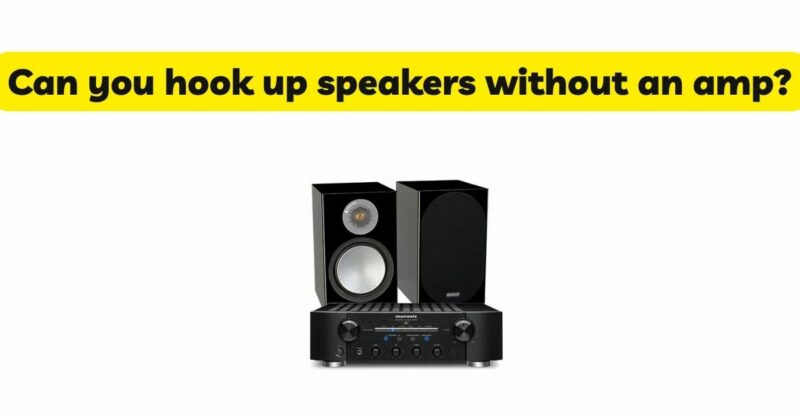When setting up speakers, one of the common questions that arises is whether it is possible to connect speakers without an amplifier. Amplifiers play a crucial role in powering and amplifying audio signals, but there are alternative methods available for those who may not have access to an amplifier. In this article, we will explore various options and techniques for connecting speakers without an amplifier, considering their benefits, limitations, and the impact on sound quality.
I. Active Speakers:
Active speakers, also known as powered speakers, are an ideal alternative for connecting speakers without an amplifier. Active speakers have built-in amplification, eliminating the need for a separate amplifier. These speakers incorporate a built-in power source, which powers the speakers and amplifies the audio signals directly. Active speakers typically have their own volume controls and audio inputs, allowing for a simple and convenient setup. This makes them a suitable choice for those who want a compact and straightforward audio solution.
II. Powered Mixers:
Powered mixers are another option for connecting speakers without a separate amplifier. A powered mixer combines a mixer and an amplifier in one unit. These mixers provide multiple audio inputs, allowing you to connect various audio sources like microphones, musical instruments, or media players. The built-in amplifier in the powered mixer then amplifies the audio signals and powers the connected speakers. Powered mixers offer greater flexibility and control over the audio signals, making them a popular choice for live performances, small venues, or events where a mixer is required along with speaker amplification.
III. Active Subwoofers:
In situations where a subwoofer is the primary concern, active subwoofers provide an alternative solution for connecting speakers without an amplifier. Active subwoofers have a built-in amplifier specifically designed to power the subwoofer unit. These subwoofers receive the low-frequency audio signals from a source component, amplify them, and reproduce the deep bass frequencies. While active subwoofers are designed specifically for low-frequency reproduction, they may not be suitable for powering full-range speakers, as they are optimized for sub-bass frequencies only.
IV. Wireless Speaker Systems:
Wireless speaker systems offer yet another option for connecting speakers without the need for an amplifier. These systems utilize wireless technology, such as Bluetooth or Wi-Fi, to transmit audio signals from a source device directly to the speakers. Wireless speakers typically have built-in amplification, allowing them to receive and amplify the audio signals wirelessly. This wireless setup eliminates the need for physical connections and provides convenience and flexibility in speaker placement. However, it’s important to note that wireless speaker systems may have limitations in terms of audio quality and range, depending on the specific technology and implementation.
V. Considerations for Speaker Connections Without an Amplifier:
While it is possible to connect speakers without an amplifier using the aforementioned alternatives, there are some considerations to keep in mind:
- Power Requirements: Ensure that the speakers or alternative options you choose have the necessary power capabilities to drive the speakers effectively. Matching the power ratings and impedance requirements of the speakers with the chosen alternative is crucial for optimal performance.
- Sound Quality: While active speakers, powered mixers, and wireless speaker systems can provide convenient solutions, it’s important to consider the impact on sound quality. Dedicated amplifiers often offer superior amplification and signal processing, which can result in better sound reproduction and fidelity.
- System Scalability: Consider the scalability of the setup. If you plan to expand your audio system in the future or connect additional speakers, alternatives that provide flexibility for expansion, such as powered mixers or wireless systems, may be more suitable.
- Compatibility and Connectivity: Ensure that the chosen alternative aligns with the audio sources you intend to use. Check for compatibility with the input options and connectivity features to connect your preferred audio devices seamlessly.
Conclusion:
While amplifiers play a critical role in powering and amplifying audio signals for speakers, there are alternative options available for connecting speakers without an amplifier. Active speakers, powered mixers, active subwoofers, and wireless speaker systems offer viable alternatives for different audio setups and requirements. However, it’s important to consider factors such as power requirements, sound quality, system scalability, and compatibility when opting for these alternatives. Each alternative comes with its own benefits and limitations, and finding the right solution depends on your specific needs, budget, and desired audio performance.


